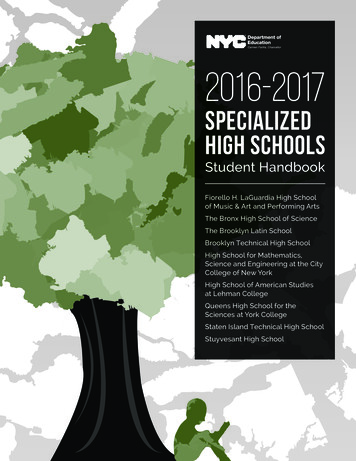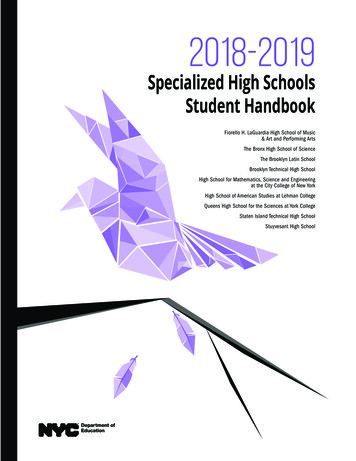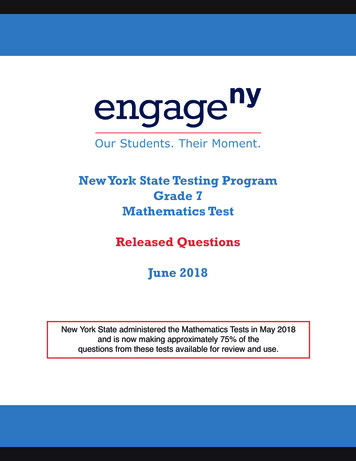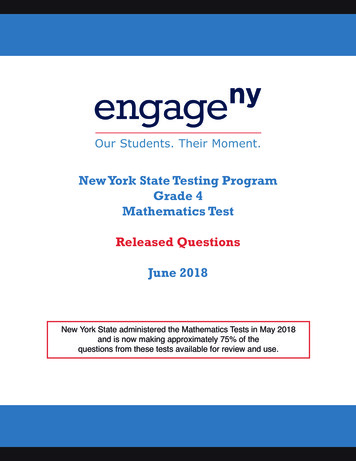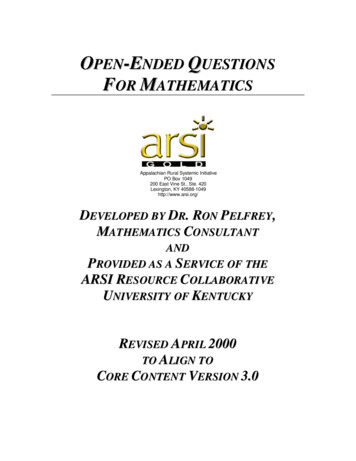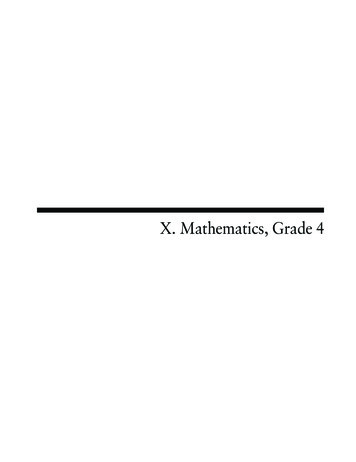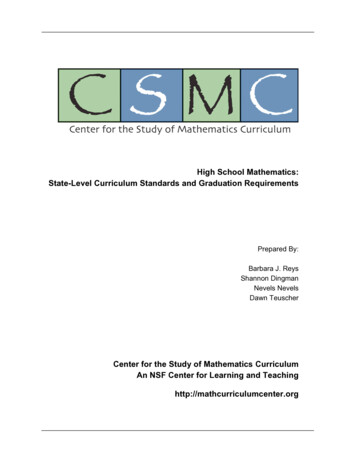
Transcription
High School Mathematics:State-Level Curriculum Standards and Graduation RequirementsPrepared By:Barbara J. ReysShannon DingmanNevels NevelsDawn TeuscherCenter for the Study of Mathematics CurriculumAn NSF Center for Learning and Teachinghttp://mathcurriculumcenter.org
This report was developed as part of the work of the Center for the Study of MathematicsCurriculum, supported by the National Science Foundation under Grant No. ESI-0333879.Any opinions, findings, and conclusions or recommendations expressed in this materialare those of the author(s) and do not necessarily reflect the views of the National ScienceFoundation.April 2007Page 2Curriculum for High School Mathematics
High School Mathematics:State-Level Curriculum Standards and Graduation RequirementsIn a continuing effort to improve student-learning opportunities in mathematics, statedepartments of education have focused on articulating standards or learning goals at all levels,including high school mathematics. A review of K-8 mathematics curriculum standards (many ofwhich have been published since 2002) compiled by staff from the Center for the Study ofMathematics Curriculum (CSMC) documents variation in the organization, specification, andgrade placement of important learning goals across states (Reys, 2006). Mathematicscurriculum standards for high school, while less common than for grades K-8, are receivingincreased attention as a means to strengthen the rigor and raise expectations for what countsas a high school diploma in the U.S. In addition, many states are increasing the number ofcredits of mathematics required for students to receive a high school diploma, and are alsospecifying particular mathematics course requirements that students must complete, such asAlgebra I and Geometry (The American Diploma Project, 2004).This report provides a summary of the format and organization of state-level curriculumstandards, graduation requirements for high school mathematics (see Appendix A). Theinformation was gathered through searches of state departments of education websites as of9/1/06. The information was current at the time of the release of this report but due to thecontinued work of states, some changes may have occurred since then. Therefore, werecommend that those interested in particular state requirements consult the appropriatewebsite for the latest and most complete set of information. Links to the mathematicscurriculum standards pages of state department of education websites can be found at:http://mathcurriculumcenter.org/states.phpThe main elements of Appendix A include specification of:Organization of high school mathematics curriculum standards. Curriculum standards for highschool mathematics, like their K-8 counterparts, typically convey a set of mathematical learningexpectations for all students. That is, they describe the mathematics that should be the focus ofinstruction and the goals for student learning. The organizational format of these standardsvaries, with some states organizing learning expectations/standards by course and others bygrade or grade-band. In addition, some courses are organized by subject (Algebra, Geometry,etc.), while others are organized by integrating strands across grades (Integrated Math I,Integrated Math II, etc.).Number of mathematics courses required for high school diploma/graduation. If a state requiresa minimum number of years (generally indicated by courses) of mathematics at the high schoollevel this minimum is specified in the table. In some cases, these requirements are determinedat the local rather that state level.Mathematics courses required for high school diploma/graduation. If a state requires studentsto complete particular mathematics courses for high school graduation, those courses arespecified.A summary of some of the trends apparent in Appendix A follows.Curriculum for High School MathematicsPage 1
Organization of High School Mathematics Curriculum Standards States generally organize high school mathematics curriculum standards in one of threeways – by course, by grade, or by grade band.Twenty states organize high school standards by course-based learning expectations,specifying what students should know by the end of a particular course (e.g., Algebra I orIntegrated Math I). Six states specify learning expectations by grade and twenty-eight statesorganize standards by grade-band specifying what students should study within a set of grades(e.g., grades 9-10) or by the end of a grade (e.g., by the end of grade 12). The most commongrade-band organization is grades 9-12 (17 states organize standards in this way). Two states(Kentucky and Massachusetts) specify standards by course and by grade band. States that organize standards by courses generally utilize a traditional subject-basedapproach.Nineteen states specify course-based learning expectations for Algebra I, twenty states forGeometry, and 18 states for Algebra II. In all but a few cases, one or more of these subjectbased courses are required for a high school diploma. See Table 1 for a list of states that offercourse-based learning expectations for various high school mathematics courses. Six states provide standards organized for integrated high school mathematics courses.That is, these states specify standards for course sequences that include emphasis onmultiple strands such as algebra, geometry, and statistics each year.Five states (Florida, Indiana, North Carolina, New York, and Tennessee) specify high schoolmathematics curriculum standards for both integrated and subject-based course sequences.For example, Indiana provides standards organized into two course sequences (Algebra I,Geometry and Algebra II; Integrated Mathematics I, II, III). New York includes one course(Integrating Algebra) that specifies curriculum standards from multiple strands. The remainingNew York course-based standards are organized into subject-based courses (Geometry,Algebra II, Trigonometry). Georgia organizes high school mathematics standards through threeintegrated course-sequences, one for each of three career or college-ready options.Table 1. States that provide course-specific high school mathematics learning expectations or outlines.CourseAlgebra IGeometryAlgebra IIIntegrated Mathematics IIntegrated Mathematics IIIntegrated Mathematics IIIPrecalculusTrigonometryProbability & StatisticsCalculusPage 2StatesAL, AR, CA, DC, FL, HI, IN, KY, MD, MA, MS, NC, OK, SC,TN, TX, UT, VA, WVAL, AR, CA, DC, FL, HI, IN, KY, MD, MA, MS, NC, NY, OK,SC, TN, TX, UT, VA, WVAL, AR, CA, DC, FL, HI, IN, MA, MS, NC, NY, OK, SC, TN,TX, UT, VA, WVFL, GA, IN, NY, NC, TNFL, GA, IN, NC, TNFL, GA, IN, NC, TNAL, DC, FL, IN, MA, MS, NC, SC, TN, TX, UT, WVCA, FL, HI, MS, NY, VA, WVAR, CA, DC, FL, HI, IN, MS, NC, SC, TN, UT, VA, WVCA, FL, HI, IN, MS, NC, SC, TN, UT, VATotal1920186551271310Curriculum for High School Mathematics
Mathematics Requirements for High School GraduationFor those states that specify a minimum number of years of mathematics for high schoolgraduation, the requirements vary from 2 to 4 years (see Table 2). Specific courserequirements for graduation also vary by state (see Table 3). Five states allow local schools and districts to determine the number of years ofmathematics to be completed in order to graduate high school.Although many states articulate the number of years of mathematics required for graduation atthe state level, five states leave these decisions to local districts and schools. Colorado, Iowa,Maine, Massachusetts, and Nebraska allow local schools to determine the number of years ofmathematics and specific course requirements to earn a high school diploma. This results invariance across the state. For example, in Massachusetts 63% of local districts requirestudents to complete 3 years of mathematics in order to graduate. In Nebraska, the number ofyears of mathematics required to graduate ranges from 1-4 years. Ten states are in the process of increasing the number of years of mathematics required forstudents to graduate.There has been a recent movement in many states towards increasing the number of years ofmathematics required to graduate from high school. In the next five years, ten states will phasein an increased requirement. Five states (DoDEA, MO, NH, OR, UT) are raising theirrequirements from 2 years of mathematics to 3 years, while five other states (AR, DE, FL, MS,TX) will require students to complete 4 years of mathematics to graduate from high school, upfrom their current requirement of 3 years. About half the states require students to complete specific mathematics classes as part oftheir course of study in order to earn a diploma.Along with the number of years of mathematics required in order to graduate, 25 states alsooutline specific courses that must be completed. As seen in Table 4, most of these statesrequire Algebra I, Geometry, and Algebra II, although some states offer the option of taking“equivalent” courses. Six states (DE, IN, LA, MI, NC, TN) specify that students have the optionof completing integrated course sequences to meet their course requirements. Five states offer multiple diploma options for students, with each option requiring varyingnumber of mathematics credits and specific courses.In some states, requirements for courses and the number of years of mathematics dependsupon the type of diploma a student seeks. In fact, five states offer multiple diplomas, each withdifferent requirements for graduation. Georgia offers two degree programs: aTechnology/Career-Preparatory and Technology Career Preparatory with Distinction programthat requires 3 years of mathematics and a College Preparatory and College Preparatory withDistinction programs that require 4 years. Virginia also offers two different degree programs forthose seeking a standard diploma and an advanced studies diploma. The states of Indiana andSouth Dakota offer 3 different diploma programs with varying requirements, while NorthCarolina outlines 4 diplomas that students can attain, varying between 3-4 years of requiredmathematics.Curriculum for High School MathematicsPage 3
Table 2. Number of years of high school mathematics courses/credits required for graduation*Specified atLocal LevelCO, IA, ME,MA, NE1 year2 years3 yearsAK, AZ, CA,ID, MT, ND,WI504 yearsCT, DC,DoDEA, HI, IL,KS, KY, LA,MD, MN, MO,NH, NM, NJ,NV, NY, OH,OK, OR, PA,TN, UT, VT,WY247AL, AR, DE,FL, MI, MS,RI, SC, TX,WA, WVVaries byDiplomaIN (2-4 yrs)GA (3-4 yrs)NC (3-4 yrs)SD (3-4 yrs)VA (3-4 yrs)115* This information includes requirements that have been approved and are being phased in with a particular freshman class.Table 3. Courses required for high school graduation/diplomaCourseStates Requiring CourseTotalAlgebra IAL, AR, CA, DoDEA, DC*, FL*, GA*, IL, KY, MD, MI,MS, ND, NH, NM**, OK**, SD, TX, UT*19Algebra I orIntegrated Mathematics IIN, LA*, NC, TN*4GeometryAL, AR, DoDEA, IL, KY, MD, MI, TX, UT*9Geometry or IntegratedMathematics IIAlgebra IIAlgebra II orIntegrated Mathematics IIIAlgebra I, Geometry, Algebra IIorIntegrated Mathematics I-III0AR, MI2DE*1LA, TN*, VA3* Or an equivalent course** Minimum RequirementSummaryThe federal No Child Left Behind (NCLB) Act has prompted increased activity at the state levelin the specification of mathematics curriculum learning goals in the United States. As a directresult of NCLB, 39 states have replaced or revised their mathematics curriculum standardssince 2002 (Reys, 2006).Along with the NCLB requirements focusing on curriculum, states have also increasedgraduation requirements in order to engage their students in more mathematics throughout theirsecondary education. The information in this report illustrates that states vary with respect torequired mathematics credit hours and courses for graduation.Page 4Curriculum for High School Mathematics
ReferencesThe American Diploma Project. (2004). Ready or not: Creating a high school diploma thatcounts. Washington, DC: Achieve, Inc.Reys, B.J. (Ed.) (2006). The Intended Mathematics Curriculum as Represented in State-LevelCurriculum Standards: Consensus or Confusion? Greenwich, CT: Information Age Publishing,Inc.Curriculum for High School MathematicsPage 5
Appendix A. State-Level Standards, Required Years and Courses for High School MathematicsStateALOrganization of High School Mathematics Curriculum pectations(by strand)(by strand)SubjIntA1, G, AC, A2, A2wT,XA3wS, PCAK9, 10AZXCAXRequiredMathematicsCourses for High1School Graduation4 yearsA1 and G2 years9-12ARRequired Years ofMathematics forHigh SchoolGraduationA1, A1A, A1B, G, GA,GB, IG, AC, A2, A3,TCM, PCwT, ST, CMA1, G, A2, PS, TR, LA,MA, CACO9-12CT9-122 years4 yearsA1, G, A22 yearsA1Determined bylocal school3district.3 yearsContent equivalentto A2 (subjectbased orintegrated), mathcourse required insenior year.A1, G, and onecourse beyond4 yearsDE9,10,11DODDC9-12XA1, G, A2, PS, PCFL9-12GAHIXXCRM1, CRM2, CRM3,CRM4 (post-sec.options)M1, M2, M3, M4 (entercalculus in college)ACM1, ACM2, ACM3(AP calculus in highschool)PA, A1, A2, G, TR, AG,PR, ST, CAID3 years3 yearsA1 or equivalent4 yearsA1 or equivalent3-4 years59, 102 yearsIL3 yearsIAHigh schoolDetermined bylocal schooldistrict.XXKYX2-4 yearsA1, A2, G, IM1, IM2,IM3, PC, CA, PS, DMKSA1, GMinimum of A1 orequivalent, otherrequirements varyby diploma type.3 yearsEarly hs, latehsIN49-103 yearsHigh school3 yearsA1 and G5Minimum of A1 orequivalent, otherrequirements varyby diploma type.Algebraic andgeometric conceptsA1, G, mathelective1Current or new requirements proposed for future graduates, if approved by governing body.“Subj” refers to subject-based course learning expectations (algebra, geometry, statistics, etc.). “Int” refers to course learningexpectations organized to integrate multiple subjects.3Colorado Commission on Higher Education established minimum admission requirements to enter all public four-year institutionswithin the state.4Florida provides 58 high school course descriptions organized in 14 categories (one category is Integrated Mathematics)5Varies by diploma type.2Page 6Curriculum for High School Mathematics
Appendix A (cont.)StateOrganization of High School Mathematics Curriculum ectations(by strand)(by strand)SubjIntLA9,10MEMDXA/DA, GMAXA1, G, A2, PC11-123 yearsOne unit from:A1 or A1A and A1Bor IM1. Remainingyears from: IM2,IM3, G, A2, FM,AM1, AM2, PC,CA, PS, DM9-diplomaDetermined bylocal schooldistrict.A/DA, G9-10, 11-12Determined bylocal school6district.MIHigh school4 yearsRequired coursesare set by the localdistrict.A1, G, A2, and onecredit in senioryear. Integratedcourse sequence isan acceptablealternative.MN9-11, 11-123 yearsA1, A24 yearsA1 and at least onehigher than A1PA, TA, A1, G, A2, AA,TR, PC, DM, CA, ST,SU, IEXMO3 years9, 10, 11, 12MT9-122 yearsNE9-12Determined at7local level9-123 yearsNVNCxxIntroductoryMathematics, A1, G, A2,TXM1, TXM2, AF, DM,PC, IM1, IM2, IM3, IM4,PS, CA3-4 years5Minimum of A1 orequivalent, otherrequirements varyby diploma type.ND9-10, 11-122 yearsA1 and anothermath courseNHHigh school(9-10) andAdv. Math(11-12)3 yearsA1NJ9-123 yearsNM9-123 yearsNYxxIA, G, A2, TROH7RequiredMathematicsCourses for HighSchool Graduation3 yearsMS6Required Years ofMathematics forHigh SchoolGraduation3 years9, 10, 11, 12at least one ofwhich is equivalentto the a A1 level orhigherAt a moreadvanced levelthan grade eight3 yearsIn most recent year, 63% of districts require 3 years of mathematics.Range of 1-4 years across school districts.Curriculum for High School MathematicsPage 7
Appendix A (cont.)StateOKOrganization of High School Mathematics Curriculum ectations(by strand)(by strand)SubjIntXA1, G, A2ORRequired Years ofMathematics forHigh SchoolGraduationRequiredMathematicsCourses for HighSchool Graduation3 yearsA1, G, A2, TR, MA,CA, PS, or anymath course withcontent and/ orrigor above A1 andapproved forcollege admission.3 yearsPA9-113 yearsRI9-104 yearsSCA1, G, A2, A3, CA, DM,MT1, MT2, MT3, MT4,PC, PS.X84 years3-4 yearsSD9-12TNXTXXUTX3 unitsA1, A2, G, PC, MMAP,4 yearsA1, G, A23 units(a) A1 or AP1or(b) G or AP2orany AdvancedMathematicscourses insequence beyond(a) and (b);XA1, G, A2, AP1, AP2,PC, CA, STXA1, G, A2, TR, A2wT,CPM, PS, DM, MA, CAXA/G, A1, AP1, AP2, G,A2, CCM, TR, PS, PC9-12WAWV8Minimum of A1.Other courserequirements varyby diploma type.Must complete oneof the following: A1,IM1, or TXA. Mustalso complete oneof the following: A2,G, IM2, or TXG.FM1, FM2, A1, A2, TXA,G, IM1, IM2, IM3, A3,DM, PC, ST, CA, TXM,TXGVTVA53 years3-4 years9-105Minimum of A1, G,A2.4 years4 yearsWI9-122 yearsWY9-113 yearsFourth course can be math-related (computer science, physics, accounting)Page 8Curriculum for High School Mathematics
Course titles and codes used in Appendix A.PA – Pre-AlgebraTA – Transition to AlgebraA/G – Algebra/Geometry PreparationA1- Algebra IA1A – Algebra I-AA1B – Algebra I-BAC – Algebra ConnectionsA/DA – Algebra/Data AnalysisA2 – Algebra IIA2wT – Algebra II with TrigonometryAA – Advanced AlgebraA3 – Algebra IIIA3wS – Algebra III with StatisticsAF – Advanced Functions and ModelingAG – Analytic GeometryG – GeometryGA – Geometry AGB – Geometry BIG – Investigating GeometryFM – Financial Math 1 or 2CCM – Conceptual MathIA – Integrated AlgebraIM – Integrated Mathematics I, 2, 3, or 4M – Mathematics 1, 2, 3, or 4CRM – Core Mathematics 1, 2, 3, or 4ACM – Accelerated Mathematics 1, 2, or 3MT – Mathematics for Technologies 1, 2, 3, or 4TXM – Technical Math 1 or 2TXA – Technical AlgebraTXG – Technical GeometryAP – Applied Math 1 or 2TCM – Transition to College MathematicsMMAP – Mathematical Models with ApplicationsPC – PrecalculusPCwT – Precalculus with TrigonometryTR - TrigonometryST – StatisticsPR - ProbabilityPS – Probability and Statistics (Reg. or Adv. Placement)DM – Discrete MathematicsSU – Survey of Mathematical TopicsCPM – Computer MathematicsLA – Linear AlgebraMA – Mathematical AnalysisCA – Calculus (Reg. or Adv. Placement)IE – Introduction to EngineeringCurriculum for High School MathematicsPage 9
ABOUT THE CENTER FOR THE STUDY OF MATHEMATICS CURRICULUM (CSMC)The Center for the Study of Mathematics Curriculum, funded by the National ScienceFoundation in 2004, is engaged in a coordinated plan of scholarly inquiry and professionaldevelopment around mathematics curriculum, examining and characterizing the role ofcurriculum materials and their influence on both teaching and student learning. The goal is toengage in systemic research to illuminate the essential features and characteristics ofcurriculum materials and related teacher support that contribute to increased student learning.Major areas of CSMC work include understanding the influence and potential of mathematicscurriculum materials, enabling teacher learning through curriculum material investigation andimplementation, and building capacity for developing, implementing, and studying the impact ofmathematics curriculum materials.PRINCIPLES THAT GUIDE THE WORK OF CSMC:A well-articulated, coherent, and comprehensive set of K-12 mathematics learninggoals/standards is necessary to large-scale improvement of school mathematics.Mathematics curriculum materials play a central role in any effort to improve schoolmathematics and that their development is a scholarly process involving a continualcycle of research-based design, field-testing, evidence gathering, and revision.Teaching and curriculum materials are highly interdependent and increasingopportunities for student learning rests on better understanding the relationshipbetween curriculum and instruction.Research addressing mathematics curriculum can inform policy and practice and inso doing narrow the gap between the ideal and the achieved curriculum.CENTER PARTNERS:Michigan State UniversityUniversity of MissouriWestern Michigan UniversityGrand Ledge MI Public SchoolsKalamazoo MI Public SchoolsColumbia MO Public zon Research, Inc.University of Chicago
Algebra I or Integrated Mathematics I IN, LA*, NC, TN* 4 Geometry AL, AR, DoDEA, IL, KY, MD, MI, TX, UT* 9 Geometry or Integrated Mathematics II 0 Algebra II AR, MI 2 Algebra II or Integrated Mathematics III DE* 1 Algebra I, Geometry, Algebra II or Integrated

